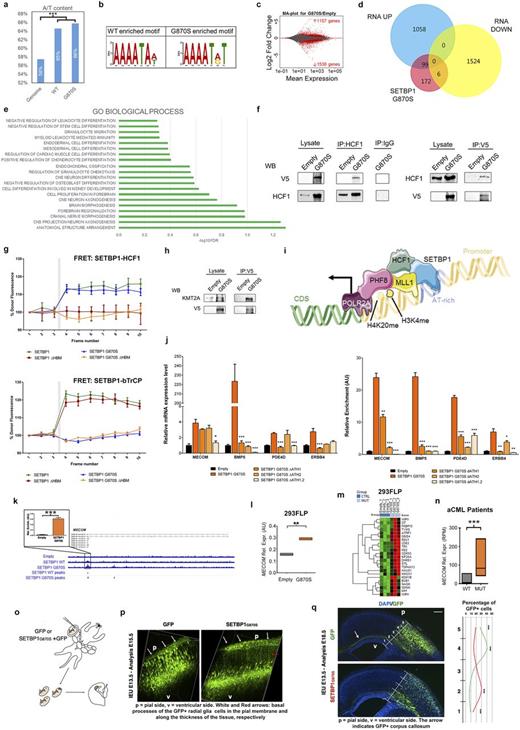Abstract
SETBP1 variants occur as somatic mutations in several hematological malignancies such as atypical Chronic Myeloid Leukemia (Piazza R et al. Nature genetics 2013) and as de novo germline mutations in the Schinzel-Giedion Syndrome (SGS) (Hoischen A et al. Nature genetics 2010), a disorder characterized by distorted neuronal layering and multi-organ development abnormalities.
Cristobal et al . showed a clear role for SETBP1 as a natural inhibitor of PP2A (Cristobal I et al. Blood 2010). However, the notion that murine Setbp1 can bind to Hoxa9/10 and Myb promoters (Oakley K et al. Blood 2012; Vishwakarma BA et al. Leukemia 2016) and that SETBP1 possesses three conserved AT-hook domains suggested a role for human SETBP1 as a DNA-binding protein.
ChIP-Seq experiments performed on 293 FLP-In cell lines harboring WT and mutated (G870S) SETBP1 revealed 3065 broad genomic regions as being bound by SETBP1-G870S. The presence of broad peaks occurred mainly in AT-rich regions (p<0.0001. Fig. 1a). De novo motif discovery identified a SETBP1 consensus binding site (AAAATAA/T; p=0.002. Fig. 1b) largely overlapping the AT-hook consensus motif (AAAATA), suggesting that SETBP1 binds gDNA through its AT-hook domains.
Differential expression RNA-Seq analysis of G870S vs Control (Empty) identified 2687 differentially expressed genes (DEGs), 57% downregulated and 43% upregulated (Fig. 1c). The intersection between genes bound by SETBP1 in promoter regions and DEGs (FDR<0.001) revealed 105 co-occurring genes. Of them, 99 (94.3%; p<1x10-6) were upregulated, suggesting a primary role for SETBP1 as a positive inducer of gene expression (Fig. 1d). Functional annotation of DEGs (Fig. 1e) highlighted a significant enrichment for ontologies related to cell differentiation and tissue development.
In line with these findings, ChIP-Seq differential enrichment analysis showed a correlation between SETBP1 promoter occupancy and increase of H3K4me2 and H3K9ac (p=1x10-4 and p=1.2x10-16, respectively; not shown). Co-immunoprecipitation/proteomics as well as FRET experiments (Fig. 1f,g) revealed a direct interaction between SETBP1 and HCF1, a core protein of the KMT2A complex, responsible for H3K4 mono- and di-methylation.
In-silico linear domain analysis suggested the presence of a putative HCF1 binding motif (HBM) occurring at position 991-994 of SETBP1. Deletion of this region caused a specific abrogation of SETBP1/HCF1 interaction (Fig. 1g) and a complete normalization of the expression level of SETBP1 target genes (not shown). Finally a direct interaction between SETBP1 and KMT2A was confirmed by co-Immunoprecipitation experiments (Fig. 1h,i).
Combined disruption of AT-hooks 1 and 2 resulted in a marked reduction of mRNA expression for all the SETBP1 target genes analyzed (MECOM p= 0.014; BMP5 p<0.001; PDE4D p<0.001; ERBB4 p=0.1. Fig. 1j, left panel). ChIP analysis confirmed the same effect (MECOM p<0.001; BMP5 p<0.001; PDE4D p<0.001; ERBB4 p=0.003.) indicating that SETBP1-gDNA interaction depends on the presence of functional AT-hooks (Fig. 1j, right panel).
ChIP-Seq data, further validated by direct ChIP experiments (Fig. 1k), showed that SETBP1 binds to the MECOM promoter. In line with these findings, MECOM ,a transcription factor often overexpressed in aggressive acute myeloid leukemias,and MECOM target genes were found to be differentially expressed (p<0.0001) in cells expressing SETBP1-G870S (Fig. 1l,m). Similar results were obtained in 32 aCML cases (11 positive and 21 negative for SETBP1 somatic mutations), where SETBP1-positive patients expressed higher levels of MECOM (p=0.0002. Fig. 1n) and MECOM target genes (p<0.0001; not shown).
Finally, transduction of radial glial progenitors of cerebral cortices of E13.5 mouse embryos with an expression plasmid encoding SETBP1-G870S using an in utero electroporation system (Fig. 1o) (Sessa A et al. Genes & development 2010) caused an impairment of mouse embryo neurogenesis with a profound delay in neuronal migration (Fig. 1p,q), indicating that SETBP1 is directly responsible for the neuroanatomical defects described in SGS.
In summary, this work unveils for the first time, using an unbiased approach, a new SETBP1 function which directly promotes gene transcription and clarifies a new mechanism operating in myeloid malignancies and in SGS.
Rea: Pfizer: Honoraria; BMS: Consultancy, Honoraria; Novartis: Consultancy, Honoraria; Incyte: Honoraria. Passamonti: Novartis Pharmaceuticals Corporation: Consultancy, Honoraria, Speakers Bureau. Gambacorti-Passerini: Pfizer: Consultancy, Honoraria, Research Funding; BMS: Consultancy.
Author notes
Asterisk with author names denotes non-ASH members.


This feature is available to Subscribers Only
Sign In or Create an Account Close Modal